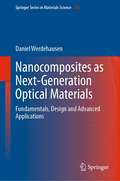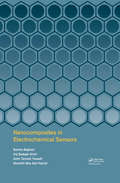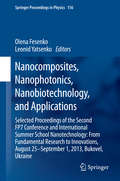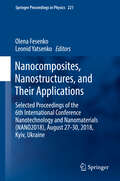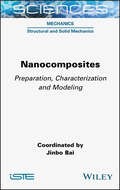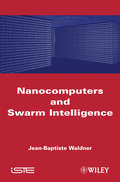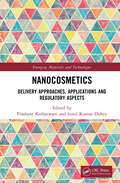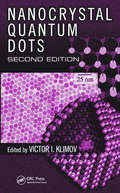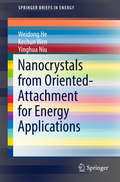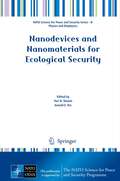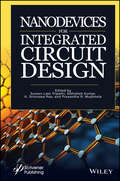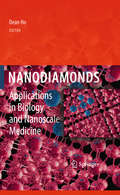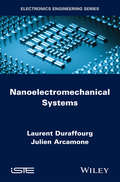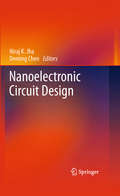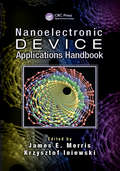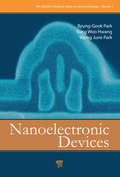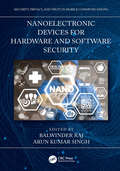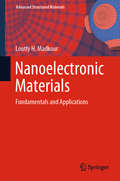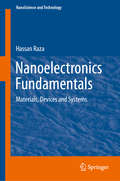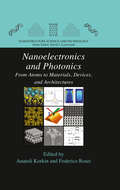- Table View
- List View
Nanocomposites as Next-Generation Optical Materials: Fundamentals, Design and Advanced Applications (Springer Series in Materials Science #316)
by Daniel WerdehausenThis book looks at advanced nanocomposites, introducing long-awaited concepts towards bridging the gap between nanostructured optical materials and next-generation imaging systems. It investigates nanocomposites as bulk optical materials and highlights the immense potential they hold for real-world optical elements and systems, such as smartphone cameras. It covers the full spectrum of nanocomposite optical materials from their fundamental properties to analytical modeling and detailed application examples. This book also provides an in-depth discussion of the role these new materials play in the development of broadband flat optics – diffractive optical elements used for enhancing high-end broadband imaging systems. Written by an industry expert, this book seamlessly connects fundamental research and real-world applications. It is the ideal guide both for optical engineers working towards integrating new technologies, and researchers involved with fundamental research on optical materials.
Nanocomposites in Electrochemical Sensors
by Iraj Sadegh Amiri Samira Bagheri Amin Termeh Yousefi Sharifah Bee Abd HamidNanotechnology has become one of the most important fields in science. Nanoparticles exhibit unique chemical, physical and electronic properties that are different from those of bulk materials, due to their small size and better architecture. Nanoparticles can be used to construct novel sensing devices; in particular electrochemical sensors. Electrochemical detection is highly attractive for the monitoring of glucose, cancer cells, cholesterol and infectious diseases. Unique nanocomposite-based films proposed in this book open new doors to the design and fabrication of high-performance electrochemical sensors.
Nanocomposites, Nanophotonics, Nanobiotechnology, and Applications
by Leonid Yatsenko Olena FesenkoThis book presents some of the latest achievements in nanotechnology and nanomaterials from leading researchers in Ukraine, Europe, and beyond. It features contributions from participants in the 2nd International Summer School "Nanotechnology: From Fundamental Research to Innovations" and International Research and Practice Conference "Nanotechnology and Nanomaterials", NANO-2013, which were held in Bukovel, Ukraine on August 25-September 1, 2013. These events took place within the framework of the European Commission FP7 project Nanotwinning, and were organized jointly by the Institute of Physics of the National Academy of Sciences of Ukraine, University of Tartu (Estonia), University of Turin (Italy), and Pierre and Marie Curie University (France). Internationally recognized experts from a wide range of universities and research institutions share their knowledge and key results on topics ranging from nanooptics, nanoplasmonics, and interface studies to energy storage and biomedical applications.
Nanocomposites, Nanostructures, and Their Applications: Selected Proceedings of the 6th International Conference Nanotechnology and Nanomaterials (NANO2018), August 27-30, 2018, Kyiv, Ukraine (Springer Proceedings in Physics #221)
by Leonid Yatsenko Olena FesenkoThis book highlights some of the latest advances in nanotechnology and nanomaterials from leading researchers in Ukraine, Europe, and beyond. It features contributions from participants in the 6th International Science and Practice Conference Nanotechnology and Nanomaterials (NANO2018) in Kiev, Ukraine on August 27-30, 2018 organized by the Institute of Physics of the National Academy of Sciences of Ukraine, University of Tartu (Estonia), University of Turin (Italy), and Pierre and Marie Curie University (France). Internationally recognized experts from a wide range of universities and research institutions share their knowledge and key results on material properties, behavior, and synthesis. This book's companion volume also addresses topics such as nanooptics, energy storage, and biomedical applications.
Nanocomposites: Preparation, Characterization and Modeling
by Jinbo BaiNanocomposites are one of the major advances in the field of materials. They have applications in sectors as varied as aeronautics, energy and the environment. However, the effective use of nanocomposites requires new knowledge and tools in order to overcome the difficulties and benefit from the advantages. Nanocomposites presents recent academic and industrial progress in this field, as well as the latest research on the effective use of nanoscale fillers and reinforcements to improve the performance of advanced nanocomposites. It also describes the techniques and tools used to prepare nanocomposites, including the latest techniques for synthesis and surface treatment of nanofillers for different applications. Finally, it details the role of nanoscience in the design, characterization and multi-scale modeling of these materials, with a focus on nanoscale phenomena.
Nanocomputers and Swarm Intelligence
by Jean-Baptiste WaldnerFor the last 50 years, the power of integrated circuits has continued to grow. However, this performance will end up reaching its physical limit. What new ways will then be available to develop even more powerful and up-to-date systems? This book introduces the principles of quantic computing, the use of nano-tubes in molecular transistors and ADN computing. It suggests new fabrication methods for the 21st century and introduces new architecture models, ranging from the most conventional to the most radical. Using a chronological theme, it explains our unavoidable entry in the nano-device world: from the 1948 transistor to the microchip. It concludes by anticipating the changes in daily living: investments, impact on coding activities, nanocomputing systems implementation and IT job mutation.
Nanocosmetics Delivery Approaches, Applications and Regulatory Aspects: Delivery Approaches, Applications And Regulatory Aspects (Emerging Materials and Technologies)
by Prashant Kesharwani Sunil Kumar DubeyThis book offers an overview of the science of cosmetics and the formulation of nanosized cosmetic products including fabrication, characterization of nanocosmetics, major challenges in the safe applications, regulatory aspects, and commercialization on a large scale. The chapters provide understanding of the interaction of nanocarriers with skin and hair, different nanocosmetic products in the present situation, applications as well as disadvantageous toxicity associated with nanocosmetics, regulatory prospects, and future perspectives. Features: Provide an explicit account on vital aspects of various nanocosmetics drug delivery approaches, thereby providing a next-generation cosmetic product. Bring together the novel applications of nanocosmetics approaches in the biological milieu. Explores preparation, applications, toxicity, and regulatory prospects. Includes a dedicated chapter on Niosomal drug-delivery systems in cosmetics. Discusses the perspectives of the technologies explored so far based upon the findings outlined in highly organized tables, illustrative figures, and flow charts. This book is aimed at researchers and professionals in nanomedicine, pharmaceuticals, biotechnology, and the health sector.
Nanocrystal Quantum Dots
by Victor I. KlimovA review of recent advancements in colloidal nanocrystals and quantum-confined nanostructures, Nanocrystal Quantum Dots is the second edition of Semiconductor and Metal Nanocrystals: Synthesis and Electronic and Optical Properties, originally published in 2003. This new title reflects the book’s altered focus on semiconductor nanocrystals. Gathering contributions from leading researchers, this book contains new chapters on carrier multiplication (generation of multiexcitons by single photons), doping of semiconductor nanocrystals, and applications of nanocrystals in biology. Other updates include: New insights regarding the underlying mechanisms supporting colloidal nanocrystal growth A revised general overview of multiexciton phenomena, including spectral and dynamical signatures of multiexcitons in transient absorption and photoluminescence Analysis of nanocrystal-specific features of multiexciton recombination A review of the status of new field of carrier multiplication Expanded coverage of theory, covering the regime of high-charge densities New results on quantum dots of lead chalcogenides, with a focus studies of carrier multiplication and the latest results regarding Schottky junction solar cells Presents useful examples to illustrate applications of nanocrystals in biological labeling, imaging, and diagnostics The book also includes a review of recent progress made in biological applications of colloidal nanocrystals, as well as a comparative analysis of the advantages and limitations of techniques for preparing biocompatible quantum dots. The authors summarize the latest developments in the synthesis and understanding of magnetically doped semiconductor nanocrystals, and they present a detailed discussion of issues related to the synthesis, magneto-optics, and photoluminescence of doped colloidal nanocrystals as well. A valuable addition to the pantheon of literature in the field of nanoscience, this book presents pioneering research from experts whose work has led to the numerous advances of the past several years.
Nanocrystals from Oriented-Attachment for Energy Applications (SpringerBriefs in Energy)
by Weidong He Kechun Wen Yinghua NiuThis brief provides a comprehensive overview of contemporary research and materials technologies utilizing oriented-attachment nanocrystals (OA NCs) for the energy conversion devices. Starting with a historical introduction, the book presents basic theory with an emphasis on thermodynamic and kinetic models of the oriented-attachment nanocrystals growth. Further chapters review recent advances in the synthesis, characterization, and application of the oriented-attachment nanocrystals in fuel cells, batteries, supercapacitors, solar cells and photocatalysis. This book will appeal to researchers and scholars from a variety of disciplines including electrochemistry, materials science, chemical engineering, physics and mechanical engineering.
Nanodevices and Nanomaterials for Ecological Security
by Arnold E. Kiv Yuri N. ShuninThis book is devoted to a wide range of problems concerning applications of nanomaterials and nanodevices as effective solutions to modern ecological problems. Leading experts in nanoscience and nanotechnology present the key theoretical, experimental and implementation issues related to the creation and utilization of novel nanoscale devices to help ensure ecological security. The authors discuss appropriate nanotechnologies for minimizing various types of risk: to human life, technogenic risk, or indeed terrorist threats. Particular emphasis is placed on defining and studying the required materials properties, and - in the field - on nanoscale devices for sensors and monitoring.
Nanodevices for Integrated Circuit Design
by Suman Lata TripathiNANODEVICES FOR INTEGRATED CIRCUIT DESIGN Nanodevices are an integral part of many of the technologies that we use every day. It is a constantly changing and evolving area, with new materials, processes, and applications coming online almost daily. Increasing demand for smart and intelligent devices in human life with better sensing, communication and signal processing is increasingly pushing researchers and designers towards future design challenges based upon internet-of-things (IoT) applications. Several types of research have been done at the level of solid-state devices, circuits, and materials to optimize system performance with low power consumption. For suitable IoT-based systems, there are some key areas, such as the design of energy storage devices, energy harvesters, novel low power high-speed devices, and circuits. Uses of new materials for different purposes, such as semiconductors, metals, and insulators in different parts of devices, circuits, and energy sources, also play a significant role in smart applications of such systems. Emerging techniques like machine learning and artificial intelligence are also becoming a part of the latest developments in an electronic device and circuit design. This groundbreaking new book will, among other things, aid developing countries in updating their semiconductor industries in terms of IC design and manufacturing to avoid dependency on other countries. Likewise, as an introduction to the area for the new-hire or student, and as a reference for the veteran engineer in the field, it will be helpful for more developed countries in their pursuit of better IC design. It is a must have for any engineer, scientist, or other industry professional working in this area.
Nanodiamonds
by Dean HoNanodiamonds: Applications in Biology and Nanoscale Medicine highlights the translation of nanodiamonds toward clinical relevance and medical applications. Integrating a spectrum of internationally-recognized experts currently developing these technologies, this book fits as a cornerstone of this exciting field. These include contributions from clinician scientists working at the interface of medicine and nanotechnologies which discuss the critical and requisite properties of nanomaterials, in a concise and cohesive manner. Nanodiamonds: Applications in Biology and Nanoscale Medicine provides a multidisciplinary overview of nanodiamonds and there uses for scientific, engineering and clinical audiences alike.
Nanodroplets
by Zhiming M. WangNanodroplets, the basis of complex and advanced nanostructures such as quantum rings, quantum dots and quantum dot clusters for future electronic and optoelectronic materials and devices, have attracted the interdisciplinary interest of chemists, physicists and engineers. This book combines experimental and theoretical analyses of nanosized droplets which reveal many attractive properties. Coverage includes nanodroplet synthesis, structure, unique behaviors and their nanofabrication, including chapters on focused ion beam, atomic force microscopy, molecular beam epitaxy and the "vapor-liquid- solid" route. Particular emphasis is given to the behavior of metallic nanodroplets, water nanodroplets and nanodroplets in polymer and metamaterial nanocomposites. The contributions of leading scientists and their research groups will provide readers with deeper insight into the chemical and physical mechanisms, properties, and potential applications of various nanodroplets.
Nanoelectrocatalysts for Energy and Water Treatment (Environmental Chemistry for a Sustainable World #74)
by Eric Lichtfouse Kumar Raju Katlego Makgopa Kwena D. ModibaneNanomaterials have recently garnered significant attention and practical importance for heterogeneous electrocatalysis. This book presents recent developments in the design, synthesis, and characterisation of nanostructured electrocatalytic materials, with a focus on applications to energy and wastewater treatment. Electrocatalytic nanomaterials can enhance process efficiency and sustainability, thus providing innovative solutions for a wide array of areas such as sustainable energy production, conversion, and wastewater treatment. Readers will gain insights into the latest breakthroughs in electrocatalysis and the activity of nanomaterials in energy conversion applications, e.g., fuel cells, hydrogen production, water splitting, and electro/photocatalytic water splitting, as well as for wastewater treatment. The book explores the development of advanced electrocatalysts, particularly hybrid materials.
Nanoelectrochemistry
by Michael V. Mirkin Shigeru AmemiyaNanoscale electrochemistry has revolutionized electrochemical research and technologies and has made broad impacts in other fields, including nanotechnology and nanoscience, biology, and materials chemistry. Nanoelectrochemistry examines well-established concepts and principles and provides an updated overview of the field and its applications.This
Nanoelectromechanical Systems
by Julien Arcamone Laurent DuraffourgThis book will present the theoretical and technological elements of nanosystems. Among the different topics discussed, the authors include the electromechanical properties of NEMS, the scaling effects that give these their interesting properties for different applications and the current manufacturing processes. The authors aim to provide useful tools for future readers and will provide an accurate picture of current and future research in the field.
Nanoelectromechanics in Engineering and Biology (Nano- and Microscience, Engineering, Technology and Medicine)
by Michael Pycraft HughesThe success, growth, and virtually limitless applications of nanotechnology depend upon our ability to manipulate nanoscale objects, which in turn depends upon developing new insights into the interactions of electric fields, nanoparticles, and the molecules that surround them. In the first book to unite and directly address particle electrokinetics and nanotechnology, Nanoelectromechanics in Engineering and Biology provides a thorough grounding in the phenomena associated with nanoscale particle manipulation. The author delivers a wealth of application and background knowledge, from using electric fields for particle sorting in lab-on-a-chip devices to electrode fabrication, electric field simulation, and computer analysis. It also explores how electromechanics can be applied to sorting DNA molecules, examining viruses, constructing electronic devices with carbon nanotubes, and actuating nanoscale electric motors. The field of nanotechnology is inherently multidisciplinary-in its principles, in its techniques, and in its applications-and meeting its current and future challenges will require the kind of approach reflected in this book. Unmatched in its scope, Nanoelectromechanics in Engineering and Biology offers an outstanding opportunity for people in all areas of research and technology to explore the use and precise manipulation of nanoscale structures.
Nanoelectronic Circuit Design
by Niraj K. Jha Deming ChenThis book is about large-scale electronic circuits design driven by nanotechnology, where nanotechnology is broadly defined as building circuits using nanoscale devices that are either implemented with nanomaterials (e.g., nanotubes or nanowires) or following an unconventional method (e.g., FinFET or III/V compound-based devices). These nanoscale devices have significant potential to revolutionize the fabrication and integration of electronic systems and scale beyond the perceived scaling limitations of traditional CMOS. While innovations in nanotechnology originate at the individual device level, realizing the true impact of electronic systems demands that these device-level capabilities be translated into system-level benefits. This is the first book to focus on nanoscale circuits and their design issues, bridging the existing gap between nanodevice research and nanosystem design.
Nanoelectronic Device Applications Handbook (Devices, Circuits, and Systems #16)
by James E. Morris Krzysztof IniewskiNanoelectronic Device Applications Handbook gives a comprehensive snapshot of the state of the art in nanodevices for nanoelectronics applications. Combining breadth and depth, the book includes 68 chapters on topics that range from nano-scaled complementary metal–oxide–semiconductor (CMOS) devices through recent developments in nano capacitors and AlGaAs/GaAs devices. The contributors are world-renowned experts from academia and industry from around the globe. The handbook explores current research into potentially disruptive technologies for a post-CMOS world. These include: Nanoscale advances in current MOSFET/CMOS technology Nano capacitors for applications such as electronics packaging and humidity sensors Single electron transistors and other electron tunneling devices Quantum cellular automata and nanomagnetic logic Memristors as switching devices and for memory Graphene preparation, properties, and devices Carbon nanotubes (CNTs), both single CNT and random network Other CNT applications such as terahertz, sensors, interconnects, and capacitors Nano system architectures for reliability Nanowire device fabrication and applications Nanowire transistors Nanodevices for spintronics The book closes with a call for a new generation of simulation tools to handle nanoscale mechanisms in realistic nanodevice geometries. This timely handbook offers a wealth of insights into the application of nanoelectronics. It is an invaluable reference and source of ideas for anyone working in the rapidly expanding field of nanoelectronics.
Nanoelectronic Devices
by Byung-Gook Park Sung Woo Hwang Young June ParkThis book provides readers with the knowledge in fundamentals of nanoelectronic devices. The authors build the principles of nanoelectronic devices based on those of microelectronic devices wherever possible and introduce the inherently nanoelectronic principles gradually. They briefly review quantum mechanics and solid-state physics that can form the basis of semiconductor device physics. The book also covers the basics of electron transport and p–n junctions, develops the operations of MOS capacitors and MOSFETs, and introduces some basic CMOS circuits. The last chapter is devoted to the nano-biotechnology application of field-effect transistors.
Nanoelectronic Devices for Hardware and Software Security (Security, Privacy, and Trust in Mobile Communications)
by Arun Kumar Singh Balwinder RajNanoelectronic Devices for Hardware and Software Security has comprehensive coverage of the principles, basic concepts, structure, modeling, practices, and circuit applications of nanoelectronics in hardware/software security. It also covers the future research directions in this domain. In this evolving era, nanotechnology is converting semiconductor devices dimensions from micron technology to nanotechnology. Nanoelectronics would be the key enabler for innovation in nanoscale devices, circuits, and systems. The motive for this research book is to provide relevant theoretical frameworks that include device physics, modeling, circuit design, and the latest developments in experimental fabrication in the field of nanotechnology for hardware/software security. There are numerous challenges in the development of models for nanoscale devices (e.g., FinFET, gate-all-around devices, TFET, etc.), short channel effects, fringing effects, high leakage current, and power dissipation, among others. This book will help to identify areas where there are challenges and apply nanodevice and circuit techniques to address hardware/software security issues.
Nanoelectronic Materials: Fundamentals and Applications (Advanced Structured Materials #116)
by Loutfy H. MadkourThis book presents synthesis techniques for the preparation of low-dimensional nanomaterials including 0D (quantum dots), 1D (nanowires, nanotubes) and 2D (thin films, few layers), as well as their potential applications in nanoelectronic systems. It focuses on the size effects involved in the transition from bulk materials to nanomaterials; the electronic properties of nanoscale devices; and different classes of nanomaterials from microelectronics to nanoelectronics, to molecular electronics. Furthermore, it demonstrates the structural stability, physical, chemical, magnetic, optical, electrical, thermal, electronic and mechanical properties of the nanomaterials. Subsequent chapters address their characterization, fabrication techniques from lab-scale to mass production, and functionality. In turn, the book considers the environmental impact of nanotechnology and novel applications in the mechanical industries, energy harvesting, clean energy, manufacturing materials, electronics, transistors, health and medical therapy. In closing, it addresses the combination of biological systems with nanoelectronics and highlights examples of nanoelectronic–cell interfaces and other advanced medical applications. The book answers the following questions: • What is different at the nanoscale? • What is new about nanoscience? • What are nanomaterials (NMs)? • What are the fundamental issues in nanomaterials? • Where are nanomaterials found? • What nanomaterials exist in nature? • What is the importance of NMs in our lives? • Why so much interest in nanomaterials? • What is at nanoscale in nanomaterials? • What is graphene? • Are pure low-dimensional systems interesting and worth pursuing? • Are nanotechnology products currently available? • What are sensors? • How can Artificial Intelligence (AI) and nanotechnology work together? • What are the recent advances in nanoelectronic materials? • What are the latest applications of NMs?
Nanoelectronics Fundamentals: Materials, Devices and Systems (NanoScience and Technology)
by Hassan RazaThis book covers the state of the art in the theoretical framework, computational modeling, and the fabrication and characterization of nanoelectronics devices. It addresses material properties, device physics, circuit analysis, system design, and a range of applications. A discussion on the nanoscale fabrication, characterization and metrology is also included. The book offers a valuable resource for researchers, graduate students, and senior undergraduate students in engineering and natural sciences, who are interested in exploring nanoelectronics from materials, devices, systems, and applications perspectives.
Nanoelectronics and Photonics
by Federico Rosei Anatoli KorkinNanoelectronics and Photonics provides a fundamental description of the core elements and problems of advanced and future information technology. The authoritative book collects a series of tutorial chapters from leaders in the field covering fundamental topics from materials to devices and system architecture, and bridges the fundamental laws of physics and chemistry of materials at the atomic scale with device and circuit design and performance requirements.
Nanoelectronics for Next-Generation Integrated Circuits
by Rohit DhimanThe incessant scaling of complementary metal-oxide semiconductor (CMOS) technology has resulted in significant performance improvements in very-large-scale integration (VLSI) design techniques and system architectures. This trend is expected to continue in the future, but this requires breakthroughs in the design of nano-CMOS and post-CMOS technologies. Nanoelectronics refers to the possible future technologies beyond conventional CMOS scaling limits. This volume addresses the current state-of-the-art nanoelectronic technologies and presents potential options for next-generation integrated circuits. Nanoelectronics for Next-generation Integrated Circuits is a useful reference guide for researchers, engineers, and advanced students working on the frontier of the design and modeling of nanoelectronic devices and their integration aspects with future CMOS circuits. This comprehensive volume eloquently presents the design methodologies for spintronics memories, quantum-dot cellular automata, and post-CMOS FETs, including applications in emerging integrated circuit technologies.
